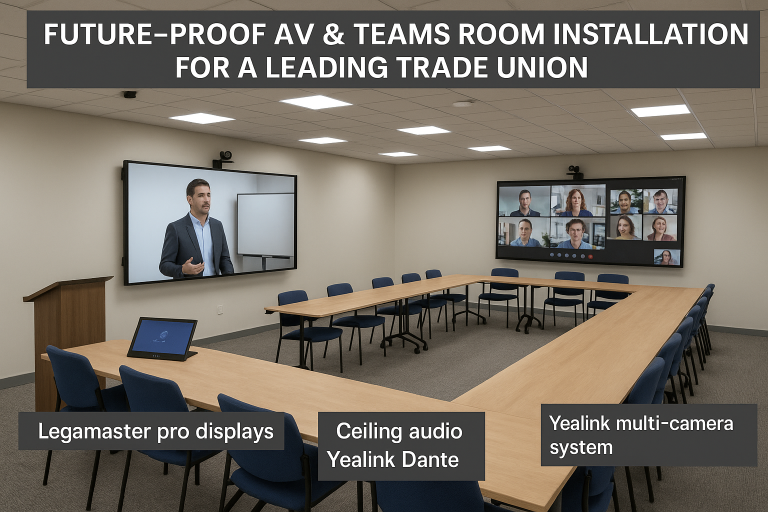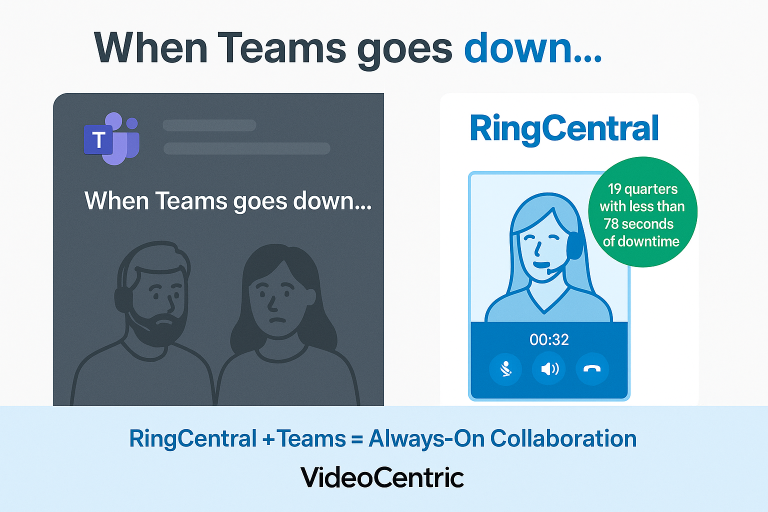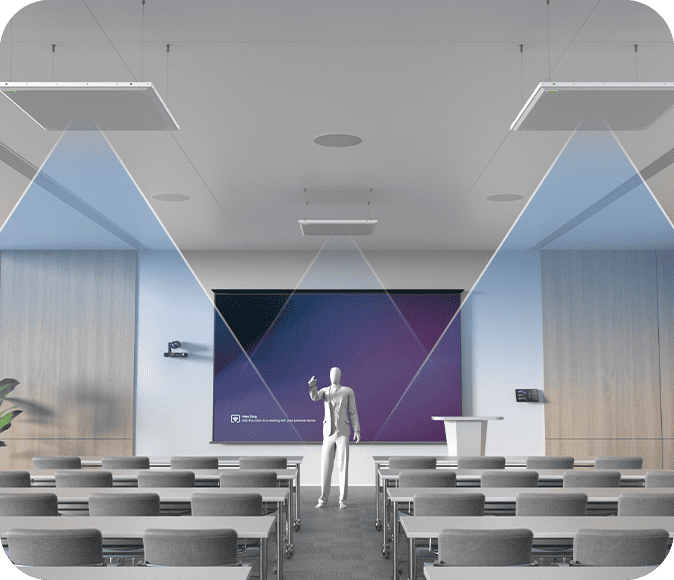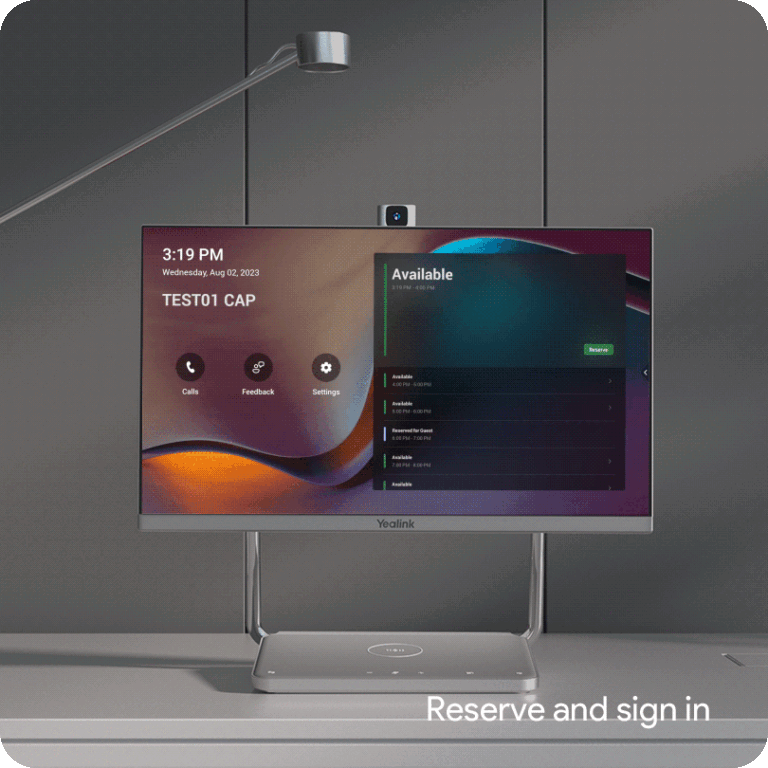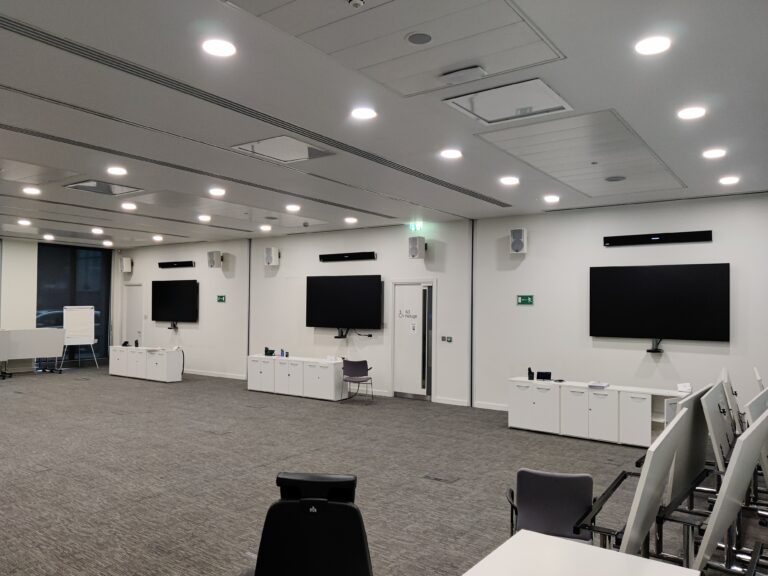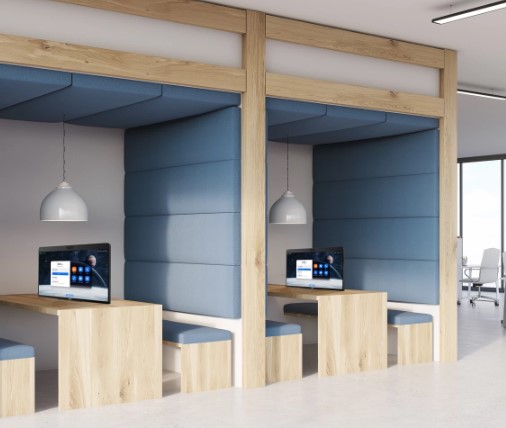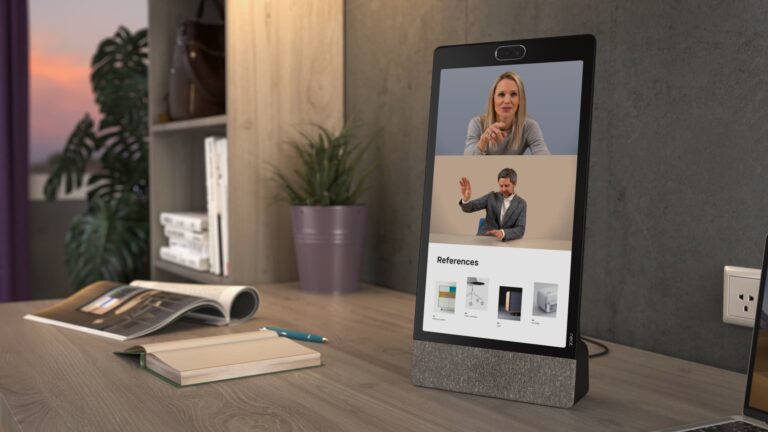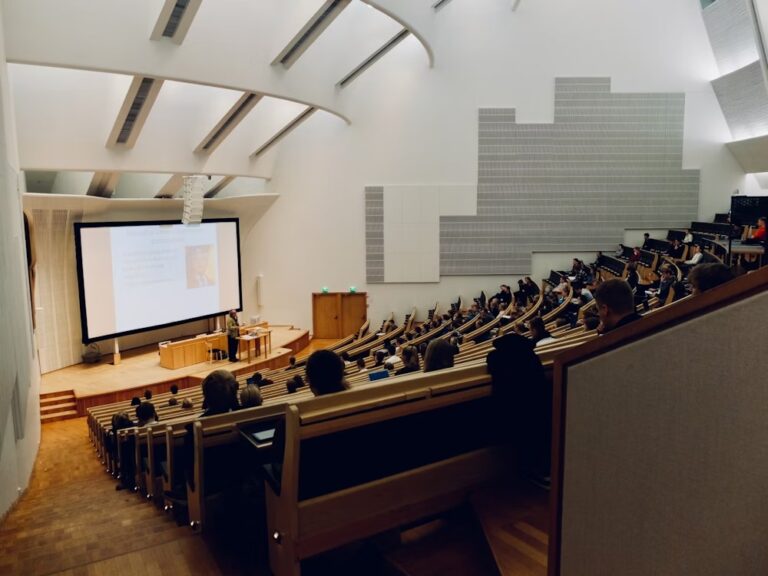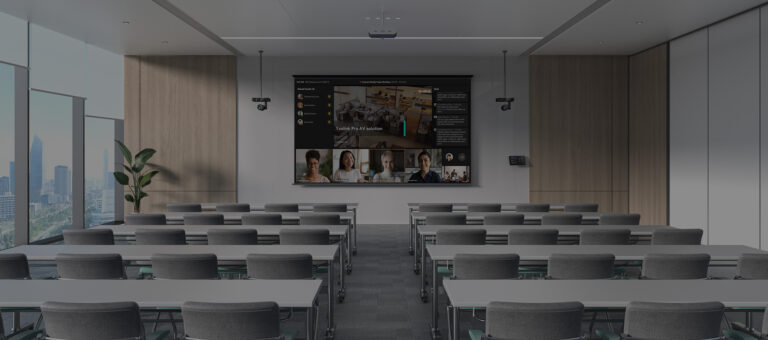The landscape of enterprise conferencing and collaboration technologies is currently at a pivotal juncture.
Formerly perceived as consumer-centric, these solutions are now making significant inroads into the corporate sphere. The convergence of consumerisation of IT and the widespread adoption of mobile devices is eroding. The traditional boundaries between business and consumer applications. Consequently, enterprise solutions must evolve to be more straightforward to implement and user-friendly while ensuring a secure and seamless communication experience. The merging realms of consumer and business communication underscore the need for a delicate balance. Capturing the attention of both end-users and IT decision-makers. Businesses must seize the opportunities arising from these transformative shifts in user preferences by deploying agile communication tools. That cater to the needs of today’s mobile users for effective collaboration regardless of their location.
A survey involving IT professionals and end-users who have integrated Google Apps into their workplace revealed that a substantial majority, comprising two-thirds of IT respondents and 58% of end-users. Are willing to invest their personal funds in technologies that enhance work efficiency and productivity. This signifies a significant departure in the usage patterns of communication applications. Has far-reaching implications for the future landscape of “enterprise” IT. Forward-thinking IT and business leaders must formulate a clear vision to facilitate applications. Fostering effective collaboration, aligning with the escalating employee inclination to accomplish tasks efficiently. Failure to do so may result in users adopting a plethora of tools independently.
An increasing number of businesses are embracing cutting-edge video and web collaboration tools to revolutionise their operations. Aiming to significantly enhance employee productivity and expand customer outreach. The democratisation of video, propelled by advancements in video technology and the widespread availability of video capabilities on personal devices. Opens up new avenues for businesses to leverage video conferencing and content sharing. Organisations can empower employees to initiate and participate in video and web collaboration using personal smartphones. While also facilitating content collaboration across platforms such as Dropbox, Google Drive, or other preferred communication applications.
Historically, the adoption of video and web conferencing faced challenges posed by complexity and costs. However, the present landscape is characterised by users who are ready to embrace a collaborative paradigm. That accommodates a distributed and mobile workforce, operating seamlessly across a variety of devices and networks. The rapid transition to next-generation devices and infrastructure is dismantling the barriers to adoption. Forward-thinking enterprises are harnessing video and web conferencing for both internal and external communications. Eliminating the need for significant capital expenditure, bulky hardware management, or the acquisition of new devices and endpoints. This shift has given rise to various applications and use cases that facilitate ubiquitous video adoption.
This paper explores the evolving trends and use cases in web and video conferencing. Emphasising the imperative for IT to offer a unified suite of communications. That encourages robust collaboration among employees and with customers. Additionally, it presents a vendor’s approach to capitalising on the growing opportunities to establish an agile business. By implementing scalable and reliable video and web conferencing solutions.
MARKET-SHAPING TRENDS: CONSUMERISATION AND THE ERA OF USER-DRIVEN IT
Integrated video cameras on laptops, smartphones, and tablets have transformed everyday devices into endpoints for video conferencing. Resulting in widespread video capabilities. Popular applications like Google Hangouts, Skype, and Facetime have successfully penetrated the business user domain. Further blurring the lines between consumer and business video usage. The convergence of consumer-oriented video solutions and the prevailing Bring Your Own Device/Application (BYOD/BYOA) trends. Has established video communications as an integral aspect of modern life.
In recent times, there has been a substantial surge in the demand for video conferencing within businesses. Driven by the pursuit of enhanced productivity, expedited decision-making processes, and the desire to cut down on travel-related expenses. Illustrating this trend, a 2016 survey conducted by Frost & Sullivan among North American decision-makers. Provides compelling statistics that underscore the pivotal role of video conferencing as an indispensable communication tool.
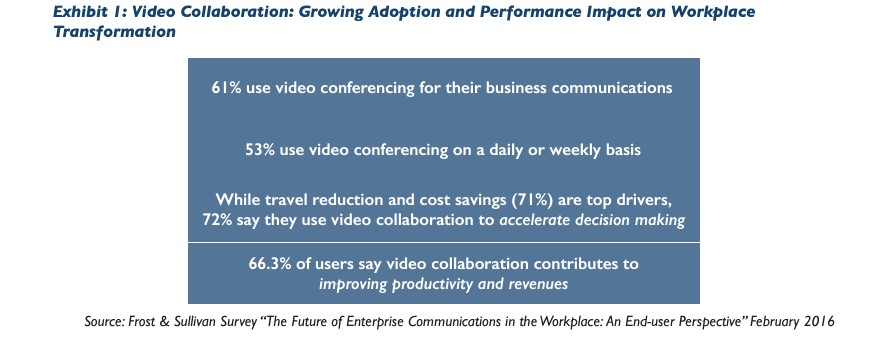
Despite the increasing desire for video conferencing, its widespread adoption has been limited. The presence of intricate solutions, elevated costs, demanding network prerequisites. A lack of interoperability has confined its usage to more “controlled” settings. Business users are now eager to expand the advantages of video conferencing to a broader range of use cases. Aiming for more immersive experiences. They aspire to achieve this with the same level of convenience, user-friendliness, and ubiquitous connectivity. That characterises their experience with consumer video. Consequently, the technologies facilitating video and web conferencing are undergoing advancements to propel the next phase of communication evolution.
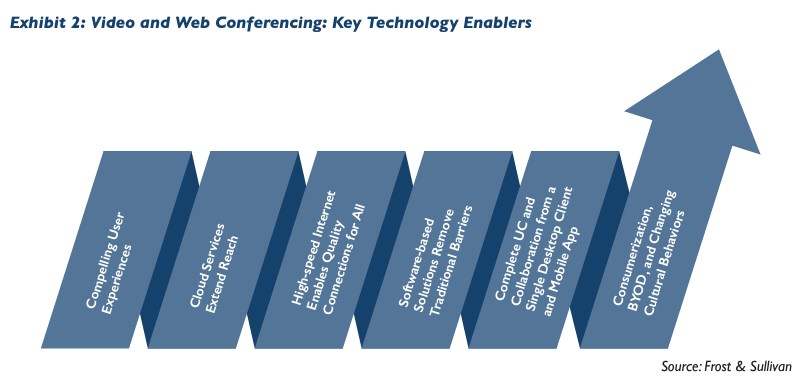
BUSINESS USE CASES FOR VIDEO AND WEB CONFERENCING
Video and web conferencing introduce an additional dimension to business interactions. Fostering a more immersive user experience while promoting collaboration and productivity. Here are some key aspects of their impact:
- Engaging Communications: By facilitating face-to-face communications through video conferencing and content sharing. Businesses can cultivate a more personal rapport among dispersed teams and with their customers. This surpasses the basic telephone services, enhancing the overall communication experience.
- Drive Sales: Quality interactions with potential clients. Not only improve the sales process but also create opportunities for upselling and cross-selling.
- Improved Decision Making: Seamless content sharing and video conferencing serve as powerful tools to illustrate complex procedures. Leading to quicker problem resolution. Additionally, the ability to observe a caller’s body language and demeanour empowers employees to make more informed decisions.
- Enhance Efficiencies: Video and web conferencing enable businesses to tap into pools of expertise and extend the reach of talent. The concept of remote experts providing services as if they were physically present. Contributes to cost efficiencies without compromising business productivity.
Video and web conferencing are driving a myriad of applications across the enterprise. Spanning areas such as marketing, sales, human resources, and investor relations. Exciting opportunities also emerge in vertical use cases (refer to Exhibit 3). For instance, envision a virtual loan specialist assisting a mortgage lender or a real estate agent showcasing properties to a remote client. Similarly, picture an enterprise technology salesperson conducting screen sharing and demonstrations for customers. These examples merely scratch the surface of the expansive realm of possibilities within video and web interactions. The opportunities are boundless and are only in the early stages of exploration.
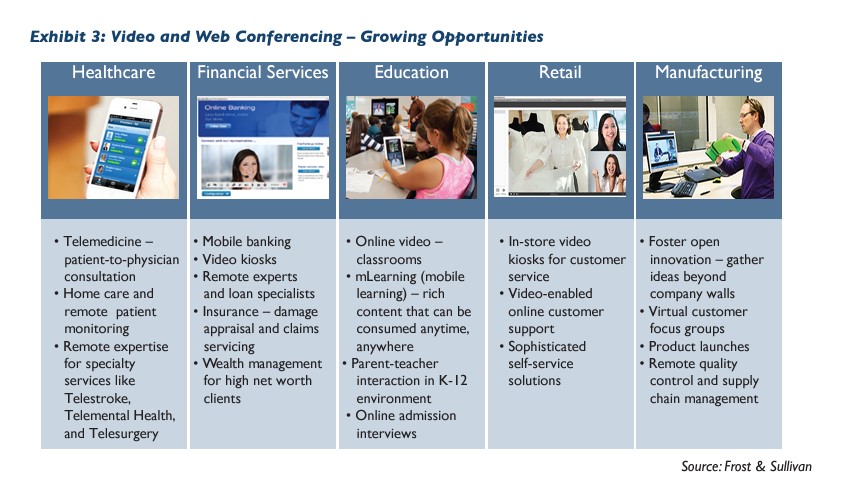
THE IMPERATIVE TO PROVIDE ANY-TO-ANY CONNECTIVITY
Technological advancements are expanding the scope and accessibility of video conferencing, extending from immersive telepresence suites and conference rooms to desktop and mobile devices. This evolution enables robust communications spanning from on-the-field consumers to the corporate boardroom. Notably, these advancements empower mobile users with an array of productivity-enhancing features, eliminating the notion of treating them as “second-class citizens.”
Key enhancements, including HD video quality and the seamless scheduling and joining of meetings, along with content sharing on the go, are transforming ordinary phone calls into productive mobile meetings. This shift is driven by the proliferation of user-driven devices, creating multiple entry points for video. According to Frost & Sullivan research, the percentage of organizations providing Bring Your Own Device (BYOD) support is expected to rise from 64% in 2013 to 79% in 2018. Additionally, the research predicts that personal (or personally liable) mobile devices will surpass corporate-owned (or corporate liable) devices in accessing enterprise IT resources in the coming years.
One of the major challenges in video and web conferencing applications is the variability in network and bandwidth conditions within consumer environments. To effectively implement video and web collaboration, businesses must prioritize solutions that exhibit high fault tolerance to cope with diverse network conditions. The advent of mobility and BYOD necessitates that users connect with anyone using their device of choice over any device or network. This requires a seamless, reliable, and continuous experience without the need to switch between multiple apps for various communication needs. Consequently, businesses must innovate to deliver agile communications capable of adapting to customers’ diverse devices, infrastructure, and networks.
SOLUTION SPOTLIGHT: 8×8 VIRTUAL OFFICE MEETINGS
In recent times, innovative approaches to video and web conferencing have successfully dismantled traditional barriers related to complexity and costs. These approaches feature more appealing pricing structures, flexible deployment models, and functionalities that cater to the collaborative needs of today’s mobile users, allowing them to work effectively from any location.
A prime example is the 8×8 Virtual Office Meetings solution, which facilitates high-quality video conferencing and content sharing seamlessly across various devices and networks. Serving over 40,000 businesses in more than 100 countries spanning six continents, 8×8 is a global leader in delivering enterprise communications-as-a-service. Renowned for its pioneering role in simplifying cloud telephony, web and video conferencing, contact centres, and business performance analytics, 8×8 continues to stay at the forefront of advancing communication technologies.
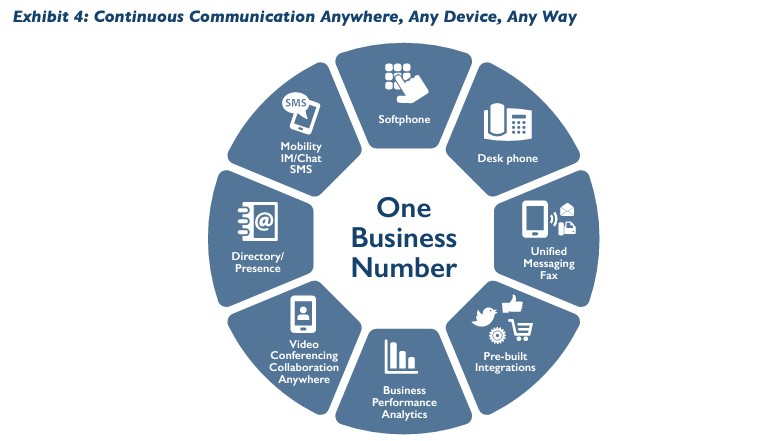
8×8 employs an as-a-service methodology, expanding the accessibility of its Virtual Office Meetings solution to both desktop and mobile users across any network, including those prone to congestion and packet loss, such as the Internet and wireless connections. Additionally, 8×8’s video and web conferencing solution is seamlessly integrated with the core cloud communications service.
This integration enables users to effortlessly schedule, join, and initiate instant meetings from a unified desktop and/or mobile app, eliminating the need to navigate between multiple applications and clients. Users benefit from a consistent identification number across devices, ensuring a smooth transition between voice calls, chats, document sharing, and video conferencing. Single sign-on (SSO) functionality and continuous access to corporate directories and presence further enhance the user experience.
The 8×8 Virtual Office Meetings feature high-quality HD video conferencing capabilities adaptable to any device and network, dynamically adjusting performance based on available bandwidth. Its robust resilience ensures optimal performance even in challenging conditions. Mobile collaboration is at the core of the 8×8 solution, allowing users to initiate collaboration sessions and share content seamlessly from popular platforms like Dropbox, Box, Google Drive, and Apple iCloud using the 8×8 mobile app. This distinctive approach effectively transforms video and web collaboration into a tangible reality for 8×8 customers.
Transportation Software Provider – TMW Systems
The Company – TMW Systems, Inc. is a leading supplier of technology solutions covering the transportation services sector.
After careful analysis of the escalating costs and management requirements, along with the feature, flexibility and disaster recovery limitations associated with TMW’s premises-based phone system, Ron Godine, director of information technology at TMW Systems, decided to implement 8×8’s Virtual Office cloud-based PBX and unified communications solution. TMW chose 8×8 Virtual Office to provide cloud-based hosted PBX and unified communications services to more than 800 employees in seven U.S. and Canadian locations. The deployment quickly grew to over 500 extensions and, soon after, TMW added unified communications capabilities, such as Web conferencing, Internet fax and call recording.
Use Case – Mobility
With the 8×8 Virtual Office cloud-based solution, TMW employees can access their core communications services from any location using an IP phone, PC and Web browser, or smart phone. In addition to enterprise class phone service with unlimited calling and a wide array of PBX calling features, the service offers unlimited Web conferencing with video, call recording and archiving, chat, Internet fax, presence and voicemail management, and a Virtual Office mobile app for iPhone, iPad and Android devices.
With our transition to 8×8’s cloud-based Virtual Office solution, we’ve been very impressed with the quality of calls, regardless of device. Now with new Virtual Office Meetings, 8×8 is taking meeting experiences to the next level with HD video and audio capabilities. TMW has over 800 employees spread in different offices across North America and we interact with hundreds of customers daily, so it’s vital that we can collaborate seamlessly and reliably, whether it’s by phone or video conferencing. -Ron Godine, Director of Information Technology, TMW Systems
In the current fiercely competitive business landscape, the leading companies are those that have pioneered inventive approaches to craft outstanding communication experiences, captivating both employees and customers. Video and web conferencing have emerged as crucial tools for fostering robust internal and external communications. However, to truly make a difference, these collaboration tools must demonstrate reliability and user-friendly intuitiveness. Consistent communication provides seamlessly integrated user experiences that align with the prevalent mobile work styles. Advancements in technology and evolving perspectives are unveiling innovative possibilities, presenting businesses with fresh avenues to establish a competitive edge. It is imperative for astute companies to quickly grasp these opportunities or risk falling behind in the dynamic business environment.

